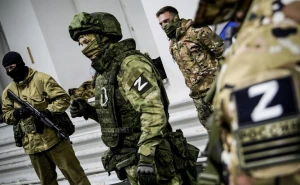
August 21-28 live war map: Russia breaks through Pokrovsk gate, storms Toretsk ‘towers’, but remains on fire
Combat clashes at the front hit a record high of 1,000 this week, with nearly half of them taking place in the Pokrovsk (380) and Toretsk (106) sectors. In southern Ukraine, particularly in the Kherson and Zaporizhzhia regions, fighting has nearly halted, with the focus now shifting closer to Vuhledar
Threat of losing Vuhledar
The city, surrounded by endless fields, has been repelling all Russian attacks for two years, holding back the offensive to the west of Donetsk and Zaporizhzhia. However, the invading forces are getting closer each week to realizing their plan to cut off logistics and surround Vuhledar. The road between Vuhledar and Kostiantynivka (a village) has already been cut by the Russians, both south of the Vodiane crossroads and to the north. In fact, this road has become a gray zone, and the Defense Forces have retreated to defend the village of Vodiane and the area around it. However, the Russian army is advancing on the village from both the south and the north. Given the trends, the Ukrainian Armed Forces may soon have to leave this settlement as well. The biggest danger for Vuhledar will be the cutting of the Vuhledar-Kurakhove highway, which the Russians only need to break through another 7 km to reach. If that happens, the southern front may collapse. However, it is unlikely to occur quickly, as since the beginning of the year, the Russians have advanced less than 10 km in this area.
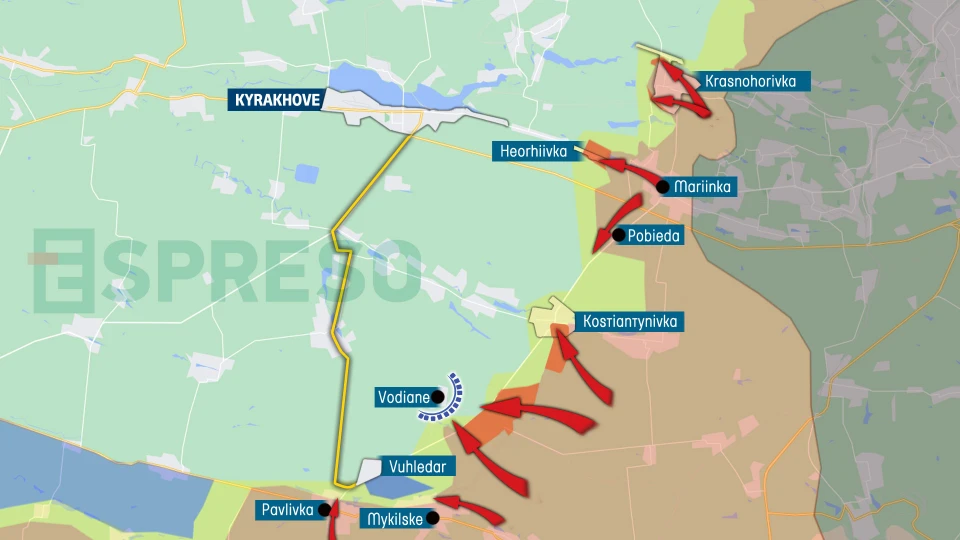
In the Kurakhove direction, Russia managed to occupy the southeastern part of Kostiantynivka village, but its further advance was stopped.
Pokrovsk crisis at the front
This week, the Russians once again set a new record for the number of attacks in the Pokrovsk sector. Currently, the Ukrainian Defense Forces are struggling to find ways to stop this 120,000-strong invasion. In the southern section of the frontline, Russian troops completely pushed the Ukrainian Armed Forces beyond the Karlivka-Selydove road and occupied the villages of Komyshivka, Ptyche, Kalynove, and Memryk. Ukraine's defenders, who have been holding the line in Karlivka for several months, are now under threat of encirclement and will soon be forced to retreat to new positions further south.
However, the most intense fighting was on the western section of the front. The Russian army advanced 4 kilometers toward Selydove, a town that was supposed to hold back the occupiers' advance. Now, the Russians are less than 2 km from reaching its outskirts.
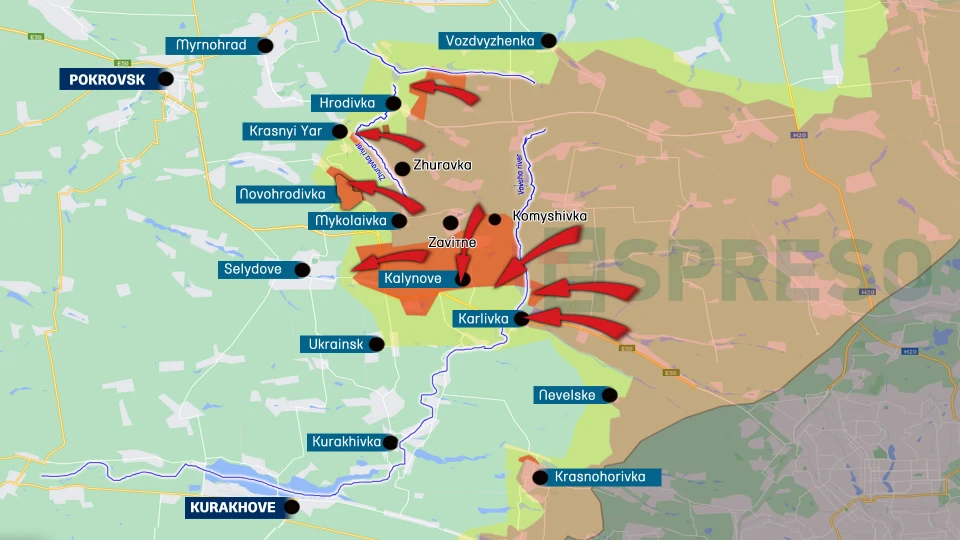
The defense of Novohrodivka, which was also expected to be a strong defensive point where the invaders would be stalled for at least a month, was the most unsuccessful. The town was practically occupied by the Russians in just a few days. The Ukrainian Defense Forces retreated, and the enemy has now opened the way to Pokrovsk and Myrnohrad, which are only 3.5 kilometers away.
The defenders of Hrodivka are holding out better. Russia has made virtually no progress in the city and is therefore forced to look for bypass routes—from the north through Novotoretske, and from the south through Krasnyi Yar. The front near Vozdvyzhenka remains unbroken.
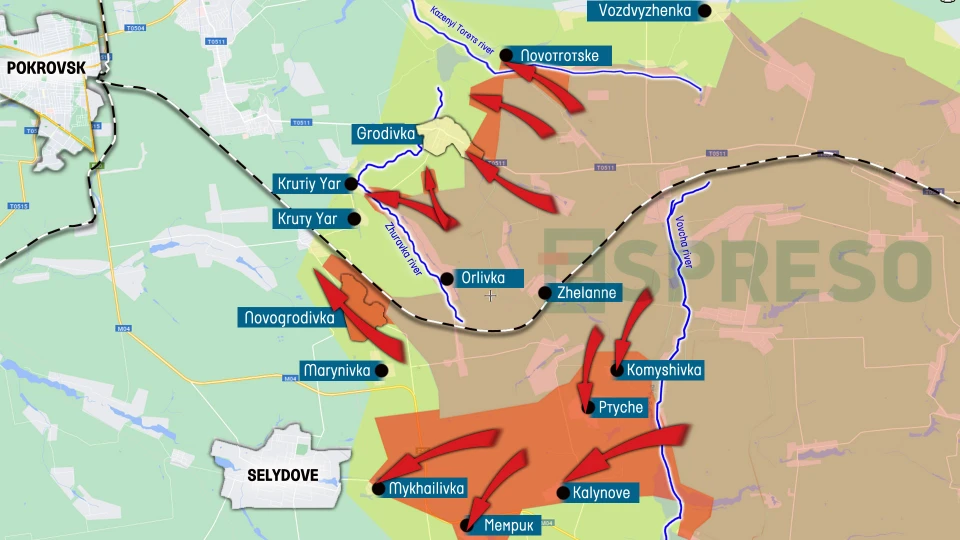
Toretsk ‘towers’ under attack
While in New York Ukraine's soldiers managed to stabilize the situation and prevent the complete occupation of the village, in Toretsk the situation is worse. The Russians managed to advance more than a kilometer along the main Dzerzhynskoho Street and seize the first spoil tip near the Pivnichna mine. In this way, they began to balance Ukraine's advantage in terms of height. The other two spoil tips in the southeastern part of the town are also under threat of occupation, as the Russians not only storm them head-on, but have also begun to flank them. After the complete occupation of Zalizne village, the Russian troops began to move westward to intensify their offensive on New York and the southern outskirts of Toretsk.
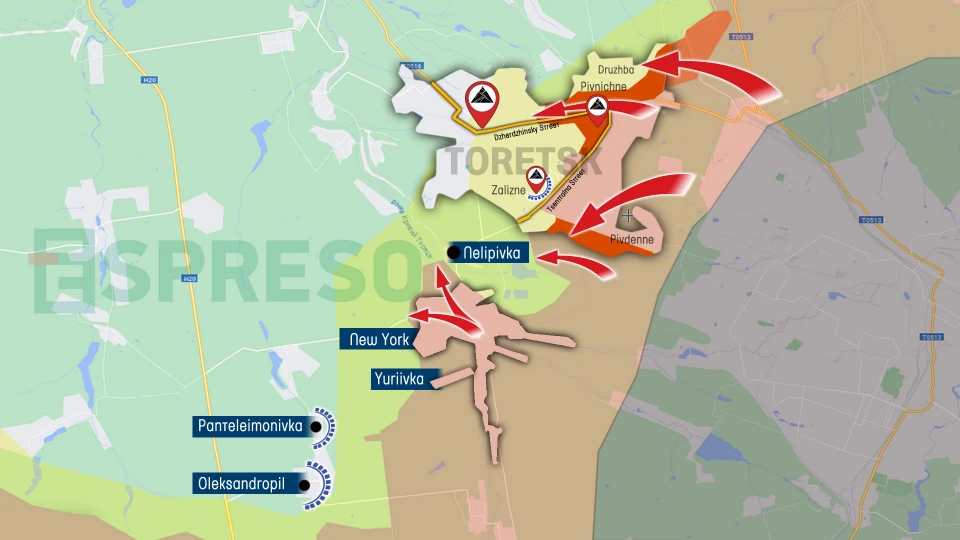
Stabilization in the Luhansk region
Russia forces continued to expand their zone of control near the village of Pishchane, which they captured a month ago, and to prepare an offensive on Kupyansk. At the same time, the Ukrainian Defense Forces not only stopped their attack on Stelmakhivka, but also launched a counteroffensive in certain areas of the front. For example, the 3rd Assault Brigade conducted a series of raids south of Raihorodka. One of them, in the area of Novovodiane, resulted in the expansion of Ukraine's control area by 5 square kilometers.
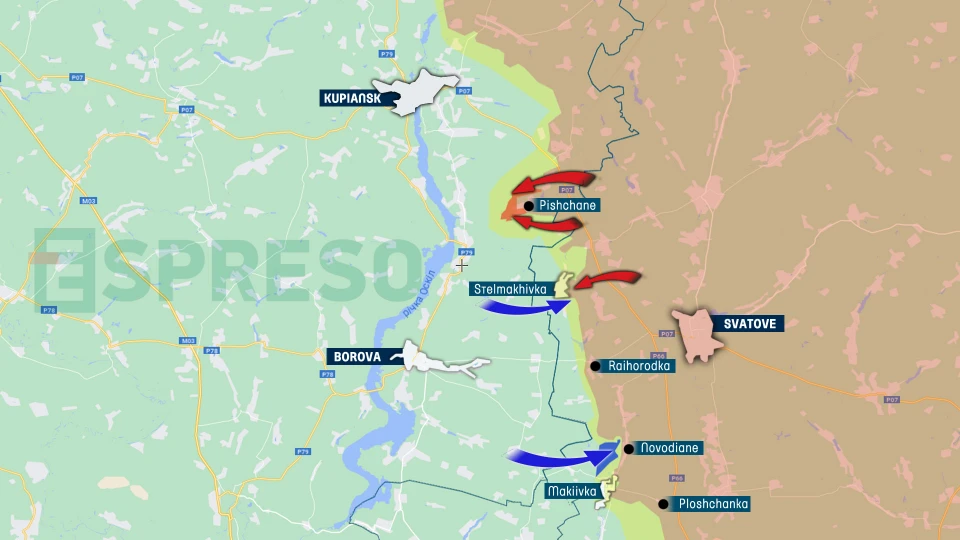
Ukraine's Armed Forces expand Kursk front and capture prisoners
Two parallel processes are underway in the Hlushkiv district, where the Ukrainian Armed Forces have encircled several thousand Russian troops. On the one hand, the Russian Armed Forces are trying to break the blockade and move additional weapons and equipment into the area. On the other hand, the Ukrainian army continues to pressure the Russians, gradually driving them into a dead end. In addition to the three destroyed bridges, the Ukrainian military has added nine more destroyed or damaged pontoon crossings, which are equally unable to provide adequate logistics. The Defense Forces crossed the Seim River and attacked north of the Tetkino checkpoint, in the Popovo-Lezhachi area. The situation in this area remains unclear, but the defenders of Tetkino are unlikely to escape this trap unscathed. On the other side of the district, the Russian forces have organized defenses along the Synyak River and the villages of Serpovka, Muzhitsa, Novoivanovka, Kulbaki, and Synyak. However, the Russians' position is precarious, as the Ukrainian Armed Forces can reach their rear at any time by crossing the border elsewhere.
The battle in Koreneve continues: Ukrainian troops are in full control of Koreneve village and the eastern part of the neighboring village. The Russians continue to defend themselves in the western part of the village, and the Ukrainian Armed Forces are trying to cut off their retreat to Rylsk.
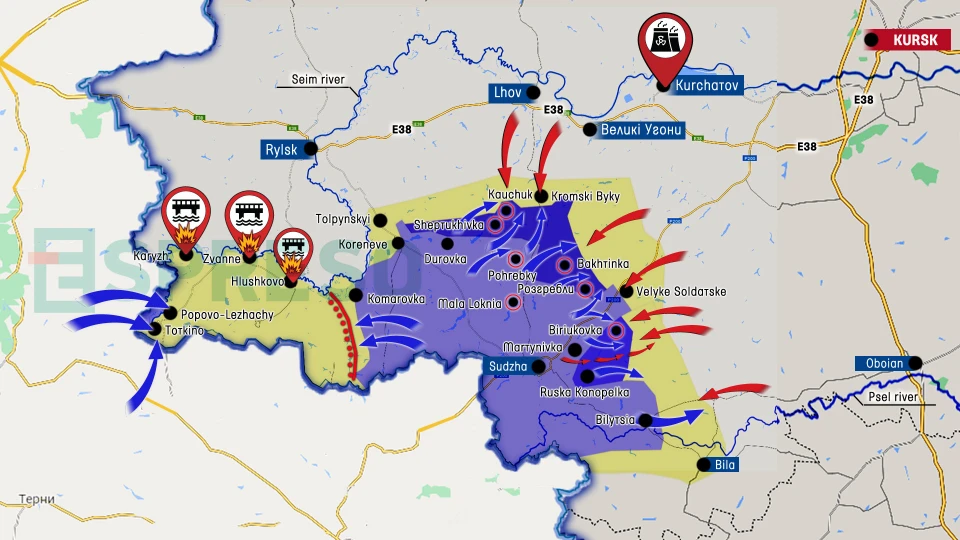
The Ukrainian Armed Forces continue to target the Rylsk-Kursk highway with drones and missiles and are conducting offensive operations in this direction. For example, near Bolshiye Ugony, Ukraine managed to destroy Kadyrov's command center, including their commander. And near the village of Durovka, they defeated and captured marines from the 810th Brigade. As the Ukrainian Defense Forces advanced toward the villages of Kromskiye Byki and Bolshoye Soldatskoye, they left behind a number of villages where Russian troops remained. This week, they have been clearing the territories that are actually under Ukrainian control. For example, the garrison in Mala Lokna was eliminated, and the defenders of Martynovka fled. The villages of Kauchuk, Sheptukhovka, Pogrebki, Biryukovka, and others are next in line for clearing. Until the garrisons of these settlements are destroyed or captured, it will be difficult for the Ukrainian Armed Forces to move forward and fully control the territory.
On the eastern flank of Ukraine's offensive, the Ukrainian Defense Forces focused not so much on advancing as on securing the flanks and expanding the territory already occupied. In particular, they successfully fought in Pushkarnoye and Russkaya Konopelka.
The Russians, on the other hand, are reinforcing their contingent in Kursk and conducting a series of counteroffensives on the eastern and northern flanks, especially in the area of Bolshoye Soldatskoye. However, it seems that they do not have confidence in their capabilities, and are therefore strengthening the fortifications in Kursk and Kurchatov, but not in Rylsk or Lgov. The Russians are calling for the evacuation of residents from the right bank of the Seim River, while those living on the left bank are asked to reach the right bank on their own, where they will then be evacuated.
At the same time, the Ukrainian Armed Forces continue their attempts to enter Russian territory in several other places in the Bryansk and Belgorod regions.
War is moving further into Russian territory
Ukrainian drones successfully attacked the Marinovka airfield in the Volgograd region, 450 kilometers from the likely strike sites in Ukraine. This was the only airfield where the Russians had built hangar shelters for the aircraft, but these did not provide sufficient protection. Of the approximately 30 aircraft in the hangars at the time, 3 to 7 fighters were either completely destroyed or severely damaged. This was the most successful attack on airfields to date, given the number of aircraft destroyed. In addition, warehouses on the airfield's territory near Volgograd were destroyed, and the airfield itself suffered catastrophic damage. This marks the fourth airfield destroyed in a month.
Given that the Ukrainian Armed Forces possess a mini cruise missile drone with a range of 600 kilometers, which is extremely difficult to intercept and even detect, a large number of Russian airfields are now under threat of destruction. Consequently, Russian aircraft will have even fewer opportunities to evade strikes in time. Additionally, Ukraine has provided the United States with a map of potential targets within the Russian Federation, a significant step toward gaining permission to strike these targets with Western weapons.
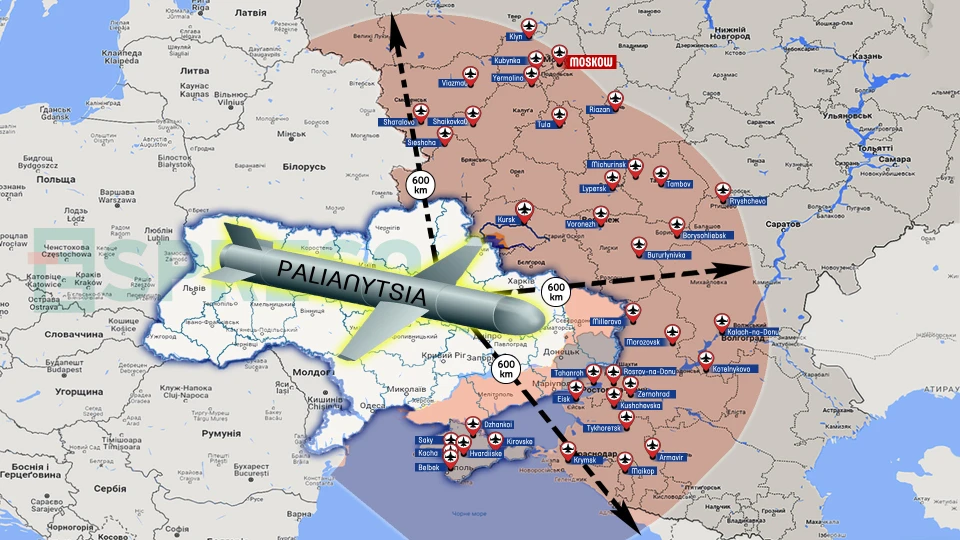
Near Voronezh, 125 kilometers from Ukraine, in the village of Novaya Melnitsa, Ukrainian missiles blew up a massive warehouse belonging to Russian Defense Intelligence. The site contained 18 warehouses storing 5,000 tons of ammunition. The resulting detonations lasted over a day, making it difficult to estimate the extent of the destruction.
In the port of Kavkaz, a Ukrainian Neptune missile sank the last railroad ferry, Conro Trader, hich was loaded with 30 railroad cars carrying fuel. This was the third attack on the port in a month. Now, Russia has no large ferries left to transport ammunition to Crimea, as the Ukrainian Armed Forces had previously hit the ferries Slavyanin and Avangard.
Meanwhile, one of the largest oil depots in the Rostov region has been burning for ten days, and an explosion occurred at the new Atlas oil depot in the same region.
Ukraine's Air Defense Forces repelled the largest Russian attack on Ukrainian cities to date. Russia launched 127 missiles of various types and 109 drones. With the help of new air defense systems and F-16s, Ukrainian forces shot down 102 missiles and 99 drones! Given the scale of the attack, the Armed Forces performed exceptionally well!
- News










